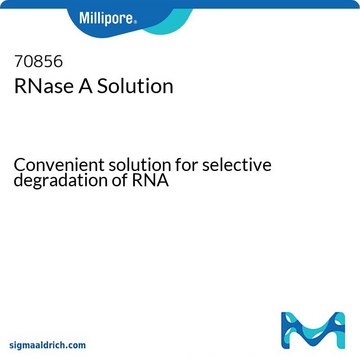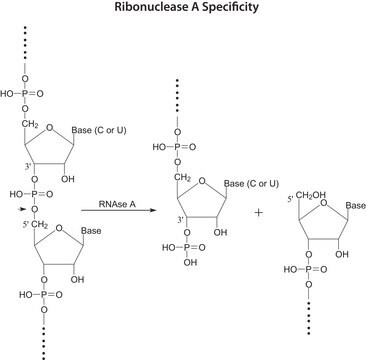R6148
RNase A solution
Synonim(y):
GenElute™ RNAse A
Zaloguj sięWyświetlanie cen organizacyjnych i kontraktowych
About This Item
Kod UNSPSC:
12352204
NACRES:
NA.52
Polecane produkty
pochodzenie biologiczne
bovine pancreas
Poziom jakości
Postać
liquid
aktywność właściwa
1500 units/mL
3000 units/mL
stężenie
20 mg/mL in Tris buffer
metody
DNA purification: suitable
temp. przechowywania
room temp
informacje o genach
bovine ... RNASE1(282340) , RNASE1(280930)
Opis ogólny
Ribonuclease A (RNase A), a protein composed of three α helices and seven β strands arranged in two "lobes” holds significance as the prototypical domain-swapped protein. It is known for its diverse oligomeric states. The RNase A family derives its name from bovine pancreatic RNase A and is specific to vertebrates. In humans, this family encompasses eight functional members, showcasing its biological relevance.
For sample preparation in GenElute™ kits.
For sample preparation in GenElute™ kits.
Zastosowanie
RNase A solution has been used:
- in apoptosis assay of Hep-2 cells
- for the colorimetric quantification of methylated DNA
- for DNA and RNA extraction
- in DNA laddering analysis
- in cell cycle analysis
- as a component in phosphate-buffered saline (PBS) to incubate cells for flow cytometry
Działania biochem./fizjol.
Ribonuclease A or bovine pancreatic ribonuclease A (RNase A) enzyme is an endoribonuclease that displays a specific ability to cleave single-stranded RNA on the 3′ side of pyrimidine residues. This endonuclease with 124 amino acids plays a key role in gene duplication, cellular metabolism, and cancer therapy. Its overexpression is closely associated with several types of cancer. Hence, RNase A has the potential to be a promising new biomarker for the diagnosis of malignant tumors and is also used as a specific target for new drug discovery. RNase A is commonly used for the isolation of plasmid DNA.
Uwaga dotycząca przygotowania
For usage requirements, please refer to the kit procedure.
Informacje prawne
GenElute is a trademark of Sigma-Aldrich Co. LLC
This page may contain text that has been machine translated.
przygotowanie próbki
Numer produktu
Opis
Cennik
Hasło ostrzegawcze
Danger
Zwroty wskazujące rodzaj zagrożenia
Zwroty wskazujące środki ostrożności
Klasyfikacja zagrożeń
Resp. Sens. 1
Kod klasy składowania
10 - Combustible liquids
Klasa zagrożenia wodnego (WGK)
WGK 3
Temperatura zapłonu (°F)
Not applicable
Temperatura zapłonu (°C)
Not applicable
Certyfikaty analizy (CoA)
Poszukaj Certyfikaty analizy (CoA), wpisując numer partii/serii produktów. Numery serii i partii można znaleźć na etykiecie produktu po słowach „seria” lub „partia”.
Masz już ten produkt?
Dokumenty związane z niedawno zakupionymi produktami zostały zamieszczone w Bibliotece dokumentów.
Klienci oglądali również te produkty
Determination of the presence of 5-methylcytosine in Paramecium tetraurelia
Singh A, et al.
PloS one, 13(10), e0206667-e0206667 (2018)
Abdou ElSharawy et al.
Oncotarget, 7(46), 75353-75365 (2016-09-30)
The emerging potential of miRNAs as biomarkers for cancer detection demands parallel evaluation of strategies for reliable identification of disease-related signatures from easily accessible and pertinent body compartments. Here, we addressed whether efficient concentration of circulating miRNA-carrying particles is a
Phenotypic plasticity and biogeographic variation in physiology of habitat-forming seaweed: response to temperature and nitrate
Flukes EB, et al.
Journal of Phycology, 51(5), 896-909 (2015)
Lenka Senohrabkova et al.
Current genetics, 65(4), 919-940 (2019-02-05)
Cells have elaborated a complex strategy to maintain protein homeostasis under physiological as well as stress conditions with the aim to ensure the smooth functioning of vital processes and producing healthy offspring. Impairment of one of the most important processes
Shiwen Zhang et al.
International journal of nanomedicine, 9, 1931-1946 (2014-05-03)
Gold nanorods (AuNRs) have been used in plasmonic photothermal therapy (PPTT), which is thought to be more efficient and selective than conventional photothermal therapy. The efficiency and safety of PPTT can be improved by functionally modifying the gold nanorods with
Nasz zespół naukowców ma doświadczenie we wszystkich obszarach badań, w tym w naukach przyrodniczych, materiałoznawstwie, syntezie chemicznej, chromatografii, analityce i wielu innych dziedzinach.
Skontaktuj się z zespołem ds. pomocy technicznej











